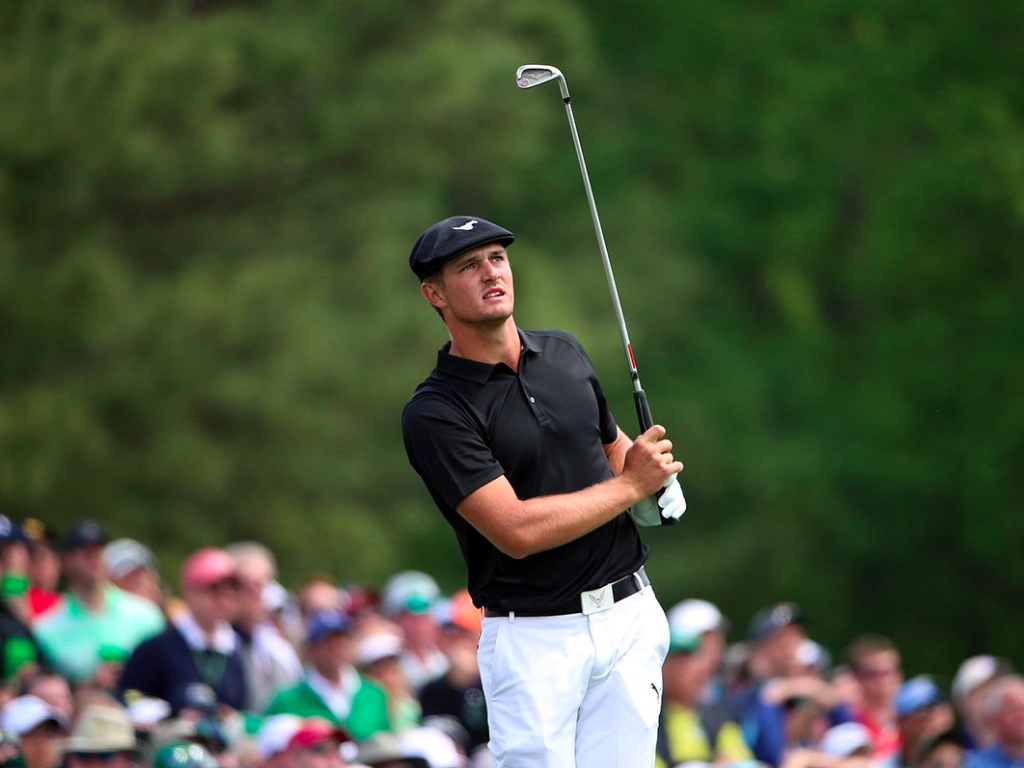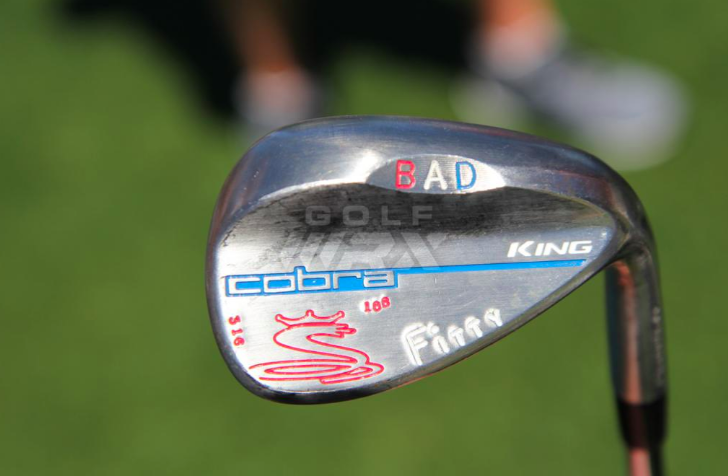Opinion & Analysis
When Bryson lit up the Masters as an amateur (Masters 2016 WITB)

When a young amateur named Bryson DeChambeau turned up at Augusta National Golf Club in 2016, there was a magnetism of curiosity attached to the 22-year-old.
After all, this was not your typical amateur golfer.
He donned a Ben Hogan style cap, was known to test his golf balls in epsom salts to check whether their centre of gravity was off and played a unique set of clubs with every iron and wedge cut to the same length as his favoured 7 iron.
In a world with so much conformity, unusualness becomes a force of its own.
That was certainly the case with Bryson at the 2016 Masters, who even had notable names for his 37.5-inch wedges and irons, which were otherwise only distinguishable from their differing lofts.
- 60-degree wedge – ‘King’ after Arnold Palmer’s 1960 Masters win
- 55-degree wedge – ‘Mr. Ward’ after the Masters Low-Am 1995 winner
- 50-degree wedge – ‘Jimmy’ after the 1950 Masters champ Jimmy Demaret
- 46-degree wedge – ‘Keiser’ after the 1946 Masters winner Herman Keiser
- 9 iron (42 degrees) – ‘Jackie’ after Jackie Robinson’s famous number 42 (same loft)
- 8 iron (38 degrees) – ‘8 ball’
- 7 iron (34 degrees) – ‘Tin Cup’ in honor of the film: 3+4=7
- 6 iron – ‘Juniper’ after the 6th hole at Augusta
- 5 iron – ‘Azalea’ after his favorite par 5 (13th hole)
- 3 iron – ‘Gamma’, which is the third letter in the Greek alphabet
DeChambeau took the trip down Magnolia Lane having, just a year previously, become only the fifth man in history to win the US Amateur Championship and the NCAA Division 1 Championship in the same year.
He had joined Jack Nicklaus, Phil Mickelson, Tiger Woods, and Ryan Moore in doing so.
Inspired by Homer Kelly’s ‘The Golfing Machine’, DeChambeau also revealed on the week of the Masters in 2016 that he had a fascination with Bobby Jones. Jones, who had famously won the Grand Slam in 1930 and had, like Bryson, altered many of his clubs so that they were also the same length.
When DeChambeau spoke about Jones and his achievements in his pre-Masters press conference, the 22-year-old suggested the possibility of doing something special.
For the opening two rounds of the event, DeChambeau was grouped with defending champion Jordan Spieth and Paul Casey – and something special was certainly abound.
While Spieth stormed into the lead with a round of 66, DeChambeau held his own against the course, opening with a level par 72, which would keep him within sight of the lead. But it was in round two where Bryson showed not just his talent but how, even as an amateur, little could faze him.
On Friday, having flown the opening green at one, DeChambeau faced a delicate chip back down the green. He poured it into the back of the cup, and a magical day was underway.

A bogey at the third followed as the scoring became increasingly difficult in the windy conditions, but as his competitors stuttered, Bryson became inspired.
Using his one plane swing, the 22-year-old birdied the seventh before spinning a wedge back to a few feet on the ninth to move to 2-under par for the event.
He would give that birdie back on 10, but despite the poor weather conditions, he would tame Amen corner, beginning with an approach to 9-feet on 11 (which he later admitted to pulling) – a hole which saw just six birdies on that Friday.

At the 12th, DeChambeau fared even better, knocking his tee shot to 2-feet. He was one off the lead.

He stayed within one of the lead after 35 holes before it all came unstuck on the 18th hole. DeChambeau pulled his tee-shot on the last and found an unplayable lie off the tee – he ended up making a triple bogey 7.
It was a sour finish that left him T8 on the leaderboard, four strokes back.
Speaking on the drive on 18, and the subsequent one which followed, DeChambeau said
“No, I hit two pulled drives. I don’t like the left-to-right wind on that hole and ultimately with this closed gap, I thought seeing those flags out there on 1 right where the leaderboard is blowing to the right,
I thought it was going to move it right, and subconsciously I came a little bit over the top and had a closed clubface. It was only two degrees closed. That’s what does it.”
A third round 77 took DeChambeau out of contention, but the youngster showed his metal on Sunday, hitting back with a round of level par thanks to a birdie on the 72nd hole.
The T21 finish gave Bryson the low-amateur award that year as well as the best finish from an amateur at Augusta since Ryan Moore finished 15th back in 2005.
The 22-year-old was as candid back then as he is today and revealed following the tournament that he had “messed up” his preparation for the event by practicing too much earlier in the week.
“Again, going back to preparation, the only thing I would change is how I spent my time resting, Monday, Tuesday, Wednesday. Unfortunately messed up and, you know what, I’m 22, I’m still young and learning how to manage my time. That’s the one thing that I think I’d change.
Ultimately my body took a toll this week and my hip. Really haven’t talked about it too much, but my hip gave out the second round, on 15, and ultimately led me to pull those two shots. I wouldn’t say that’s the full reason, but at the same time, it did affect me. It was unfortunate, but again, it’s a learning experience.”
It was the week Bryson introduced himself on the world stage and showed the massive amount of potential and determination he possessed, which would ultimately see him become a major champion.
In the next few days DeChambeau will return to Augusta National and will of course draw more attention than any other player in the field.
His introduction was one of intrigue and potential, but when he takes the trip down Magnolia Lane next week, the focus will be on whether Bryson can block out the noise, pressure and expectancy, and fulfil his destiny of becoming a Masters champion.
As a 22-year-old Bryson said after his first Masters experience:
“I think people talk about how every five years, you change as a human being, and that is absolutely true. I mean, I’ve totally changed and what I would tell younger Bryson is, be patient and keep learning every day. Those are the two things that I would tell him.”
You probably don’t need reminding. It’s been 5 years since Bryson first stole the show at Augusta National.
Bryson DeChambeau 2016 Masters WITB
Driver: Cobra King F6+ Pro (7 degrees)
Shaft: Oban Kiyoshi Tour Limited 70X
Length: 45 inches (tipped 2.5 inches)
Weight Setting: Sliding weight removed

3 wood: Cobra King F6 (14.2 degrees actual loft)
Shaft: Oban Kiyoshi Tour Limited 70X
Length: 43 inches (tipped 2 inches)
Lie Angle: 61.5 degrees

Utility: Cobra King Utility (18.5D)
Shaft: Project X HZRDUS Black Hybrid 6.5X (105 grams)

Irons: Cobra Fly-Z+ (3, 5), Edel Forged Prototype (6-9)
Shafts: KBS C-Taper Lite 115X
Length, Lie: 37.5 inches, 73 degrees
Head weight: 280 grams
Lofts: 20 (3), 25 (4), 30 (5), 34 (6), 38 (7), 42 (8), 46 (9)

Wedges: Cobra King (46, 50, 55 and 60 degrees)
Shafts: KBS Hi-Rev 135X
Length, Lie: 37.5 inches, 73 degrees
Head weight: 280 grams

Putter: Edel “The Brick” prototype
Grip: SuperStroke Slim 3.0 (Blue/White)

Ball: Bridgestone B330-S
Opinion & Analysis
The 2 primary challenges golf equipment companies face

As the editor-in-chief of this website and an observer of the GolfWRX forums and other online golf equipment discourse for over a decade, I’m pretty well attuned to the grunts and grumbles of a significant portion of the golf equipment purchasing spectrum. And before you accuse me of lording above all in some digital ivory tower, I’d like to offer that I worked at golf courses (public and private) for years prior to picking up my pen, so I’m well-versed in the non-degenerate golf equipment consumers out there. I touched (green)grass (retail)!
Complaints about the ills of and related to the OEMs usually follow some version of: Product cycles are too short for real innovation, tour equipment isn’t the same as retail (which is largely not true, by the way), too much is invested in marketing and not enough in R&D, top staffer X hasn’t even put the new driver in play, so it’s obviously not superior to the previous generation, prices are too high, and on and on.
Without digging into the merits of any of these claims, which I believe are mostly red herrings, I’d like to bring into view of our rangefinder what I believe to be the two primary difficulties golf equipment companies face.
One: As Terry Koehler, back when he was the CEO of Ben Hogan, told me at the time of the Ft Worth irons launch, if you can’t regularly hit the golf ball in a coin-sized area in the middle of the face, there’s not a ton that iron technology can do for you. Now, this is less true now with respect to irons than when he said it, and is less and less true by degrees as the clubs get larger (utilities, fairways, hybrids, drivers), but there remains a great deal of golf equipment truth in that statement. Think about it — which is to say, in TL;DR fashion, get lessons from a qualified instructor who will teach you about the fundamentals of repeatable impact and how the golf swing works, not just offer band-aid fixes. If you can’t repeatably deliver the golf club to the golf ball in something resembling the manner it was designed for, how can you expect to be getting the most out of the club — put another way, the maximum value from your investment?
Similarly, game improvement equipment can only improve your game if you game it. In other words, get fit for the clubs you ought to be playing rather than filling the bag with the ones you wish you could hit or used to be able to hit. Of course, don’t do this if you don’t care about performance and just want to hit a forged blade while playing off an 18 handicap. That’s absolutely fine. There were plenty of members in clubs back in the day playing Hogan Apex or Mizuno MP-32 irons who had no business doing so from a ballstriking standpoint, but they enjoyed their look, feel, and complementary qualities to their Gatsby hats and cashmere sweaters. Do what brings you a measure of joy in this maddening game.
Now, the second issue. This is not a plea for non-conforming equipment; rather, it is a statement of fact. USGA/R&A limits on every facet of golf equipment are detrimental to golf equipment manufacturers. Sure, you know this, but do you think about it as it applies to almost every element of equipment? A 500cc driver would be inherently more forgiving than a 460cc, as one with a COR measurement in excess of 0.83. 50-inch shafts. Box grooves. And on and on.
Would fewer regulations be objectively bad for the game? Would this erode its soul? Fortunately, that’s beside the point of this exercise, which is merely to point out the facts. The fact, in this case, is that equipment restrictions and regulations are the slaughterbench of an abundance of innovation in the golf equipment space. Is this for the best? Well, now I’ve asked the question twice and might as well give a partial response, I guess my answer to that would be, “It depends on what type of golf you’re playing and who you’re playing it with.”
For my part, I don’t mind embarrassing myself with vintage blades and persimmons chasing after the quasi-spiritual elevation of a well-struck shot, but that’s just me. Plenty of folks don’t give a damn if their grooves are conforming. Plenty of folks think the folks in Liberty Corner ought to add a prison to the museum for such offences. And those are just a few of the considerations for the amateur game — which doesn’t get inside the gallery ropes of the pro game…
Different strokes in the game of golf, in my humble opinion.
Anyway, I believe equipment company engineers are genuinely trying to build better equipment year over year. The marketing departments are trying to find ways to make this equipment appeal to the broadest segment of the golf market possible. All of this against (1) the backdrop of — at least for now — firm product cycles. And golfers who, with their ~15 average handicap (men), for the most part, are not striping the golf ball like Tiger in his prime and seem to have less and less time year over year to practice and improve. (2) Regulations that massively restrict what they’re able to do…
That’s the landscape as I see it and the real headwinds for golf equipment companies. No doubt, there’s more I haven’t considered, but I think the previous is a better — and better faith — point of departure when formulating any serious commentary on the golf equipment world than some of the more cynical and conspiratorial takes I hear.
Agree? Disagree? Think I’m worthy of an Adam Hadwin-esque security guard tackle? Let me know in the comments.
@golfoncbs The infamous Adam Hadwin tackle ? #golf #fyp #canada #pgatour #adamhadwin ? Ghibli-style nostalgic waltz – MaSssuguMusic
Podcasts
Fore Love of Golf: Introducing a new club concept

Episode #16 brings us Cliff McKinney. Cliff is the founder of Old Charlie Golf Club, a new club, and concept, to be built in the Florida panhandle. The model is quite interesting and aims to make great, private golf more affordable. We hope you enjoy the show!
Opinion & Analysis
On Scottie Scheffler wondering ‘What’s the point of winning?’

Last week, I came across a reel from BBC Sport on Instagram featuring Scottie Scheffler speaking to the media ahead of The Open at Royal Portrush. In it, he shared that he often wonders what the point is of wanting to win tournaments so badly — especially when he knows, deep down, that it doesn’t lead to a truly fulfilling life.
View this post on Instagram
“Is it great to be able to win tournaments and to accomplish the things I have in the game of golf? Yeah, it brings tears to my eyes just to think about it because I’ve literally worked my entire life to be good at this sport,” Scheffler said. “To have that kind of sense of accomplishment, I think, is a pretty cool feeling. To get to live out your dreams is very special, but at the end of the day, I’m not out here to inspire the next generation of golfers. I’m not out here to inspire someone to be the best player in the world, because what’s the point?”
Ironically — or perhaps perfectly — he went on to win the claret jug.
That question — what’s the point of winning? — cuts straight to the heart of the human journey.
As someone who’s spent over two decades in the trenches of professional golf, and in deep study of the mental, emotional, and spiritual dimensions of the game, I see Scottie’s inner conflict as a sign of soul evolution in motion.
I came to golf late. I wasn’t a junior standout or college All-American. At 27, I left a steady corporate job to see if I could be on the PGA Tour starting as a 14-handicap, average-length hitter. Over the years, my journey has been defined less by trophies and more by the relentless effort to navigate the deeply inequitable and gated system of professional golf — an effort that ultimately turned inward and helped me evolve as both a golfer and a person.
One perspective that helped me make sense of this inner dissonance around competition and our culture’s tendency to overvalue winning is the idea of soul evolution.
The University of Virginia’s Division of Perceptual Studies has done extensive research on reincarnation, and Netflix’s Surviving Death (Episode 6) explores the topic, too. Whether you take it literally or metaphorically, the idea that we’re on a long arc of growth — from beginner to sage elder — offers a profound perspective.
If you accept the premise literally, then terms like “young soul” and “old soul” start to hold meaning. However, even if we set the word “soul” aside, it’s easy to see that different levels of life experience produce different worldviews.
Newer souls — or people in earlier stages of their development — may be curious and kind but still lack discernment or depth. There is a naivety, and they don’t yet question as deeply, tending to see things in black and white, partly because certainty feels safer than confronting the unknown.
As we gain more experience, we begin to experiment. We test limits. We chase extreme external goals — sometimes at the expense of health, relationships, or inner peace — still operating from hunger, ambition, and the fragility of the ego.
It’s a necessary stage, but often a turbulent and unfulfilling one.
David Duval fell off the map after reaching World No. 1. Bubba Watson had his own “Is this it?” moment with his caddie, Ted Scott, after winning the Masters.
In Aaron Rodgers: Enigma, reflecting on his 2011 Super Bowl win, Rodgers said:
“Now I’ve accomplished the only thing that I really, really wanted to do in my life. Now what? I was like, ‘Did I aim at the wrong thing? Did I spend too much time thinking about stuff that ultimately doesn’t give you true happiness?’”
Jim Carrey once said, “I think everybody should get rich and famous and do everything they ever dreamed of so they can see that it’s not the answer.”
Eventually, though, something shifts.
We begin to see in shades of gray. Winning, dominating, accumulating—these pursuits lose their shine. The rewards feel more fleeting. Living in a constant state of fight-or-flight makes us feel alive, yes, but not happy and joyful.
Compassion begins to replace ambition. Love, presence, and gratitude become more fulfilling than status, profits, or trophies. We crave balance over burnout. Collaboration over competition. Meaning over metrics.
Interestingly, if we zoom out, we can apply this same model to nations and cultures. Countries, like people, have a collective “soul stage” made up of the individuals within them.
Take the United States, for example. I’d place it as a mid-level soul: highly competitive and deeply driven, but still learning emotional maturity. Still uncomfortable with nuance. Still believing that more is always better. Despite its global wins, the U.S. currently ranks just 23rd in happiness (as of 2025). You might liken it to a gifted teenager—bold, eager, and ambitious, but angsty and still figuring out how to live well and in balance. As much as a parent wants to protect their child, sometimes the child has to make their own mistakes to truly grow.
So when Scottie Scheffler wonders what the point of winning is, I don’t see someone losing strength.
I see someone evolving.
He’s beginning to look beyond the leaderboard. Beyond metrics of success that carry a lower vibration. And yet, in a poetic twist, Scheffler did go on to win The Open. But that only reinforces the point: even at the pinnacle, the question remains. And if more of us in the golf and sports world — and in U.S. culture at large — started asking similar questions, we might discover that the more meaningful trophy isn’t about accumulating or beating others at all costs.
It’s about awakening and evolving to something more than winning could ever promise.










Wedge Bender
Apr 2, 2021 at 9:23 pm
Holy 9 degrees upright Batman
Wedge Bender
Apr 2, 2021 at 9:22 pm
Holy 9 degrees upright Batman….
Bren
Apr 2, 2021 at 1:42 pm
Mettle?
Eddy
Apr 2, 2021 at 11:00 am
I can hardly wait till he shanks a drive a seriously injures a fan which leads to a Barkley swing.
Delbert
Apr 2, 2021 at 10:21 am
Smooth swing back then.